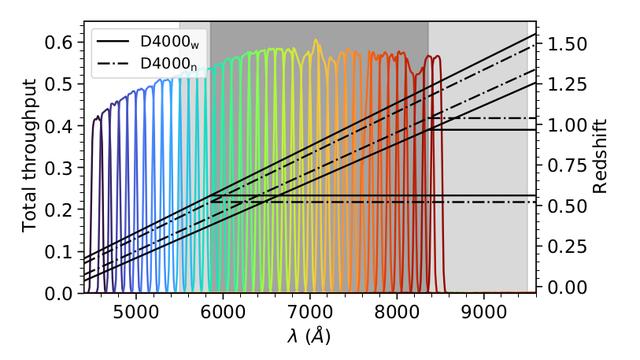New Paper
New Cosmology group paper
January 19, 2022
Observational Cosmology Group“The PAU Survey: Measurements of the 4000 Å spectral break with narrow-band photometry ” by members of the Cosmology Group and PIC has been uploaded to arXiv.
One of the most important features in the visible part of galaxy spectra is the D4000 break, generated around 4000 \AA\ by the absorption of several ionised metallic elements, as well as the latest lines in the Balmer series. D4000 is one of the most commonly proxy to estimate the stellar age of galaxies allowing the trace of the star formation history of galaxies. The direct measurement of the D4000 is generally reserved for spectroscopic surveys. For the first time, we present a general method to directly measure the D4000 spectral break index with narrow-band photometry.
This method reduces the bias in D4000 estimations on simulated galaxies by a factor of two in comparison to the previous method (Stothert at el. 2018). Together with SED fitting approach, we applied direct method to observed PAUS galaxies in the VIPERS field ($i_{\rm AB} < 22.5$, $0.5 < z < 1$). PAUS direct method shows an excellent agreement (>0.99) with spectroscopic measurements with Gaussian noise up to i_{AB}< 21, i.e. two magnitudes below PAUS completeness limit, keeping the performance on the level of ~0.9 for the full sample. Our results show that narrow-band photometry is a good proxy to recreate accurately spectral breaks, which is not achievable with broad-band photometry. Moreover, the direct narrow-band D4000 estimations might be used as a powerful classification tool to separate blue and red galaxies without the necessity of spectroscopic information or model-dependent SED-based derivable.
The relation of D4000 on stellar mass and star formation rates obtained with narrow-band photometry is in excellent agreement with the one derived from spectroscopy (within 0.5-1sigma) allowing us to study galaxy properties on a wide field with accuracy similar to the one provided by spectroscopy. Thus, the narrow-band photometry might be considered as the next step in resolving the nature vs nurture dilemma in galaxy evolution studies.

Event
Outreach talk about the latest DESI results
June 11, 2025
Sindhu Satyavolu and Laura Casas delivered the seminar “Probing Cosmic Acceleration with DESI: Is Dark Energy Evolving?” at the Sala de Graus II (UAB), in a hybrid format. The speakers presented the latest results from the Dark Energy Spectroscopic Instrument (DESI) and introduced key cosmological concepts to ensure accessibility for a non-specialist audience.
